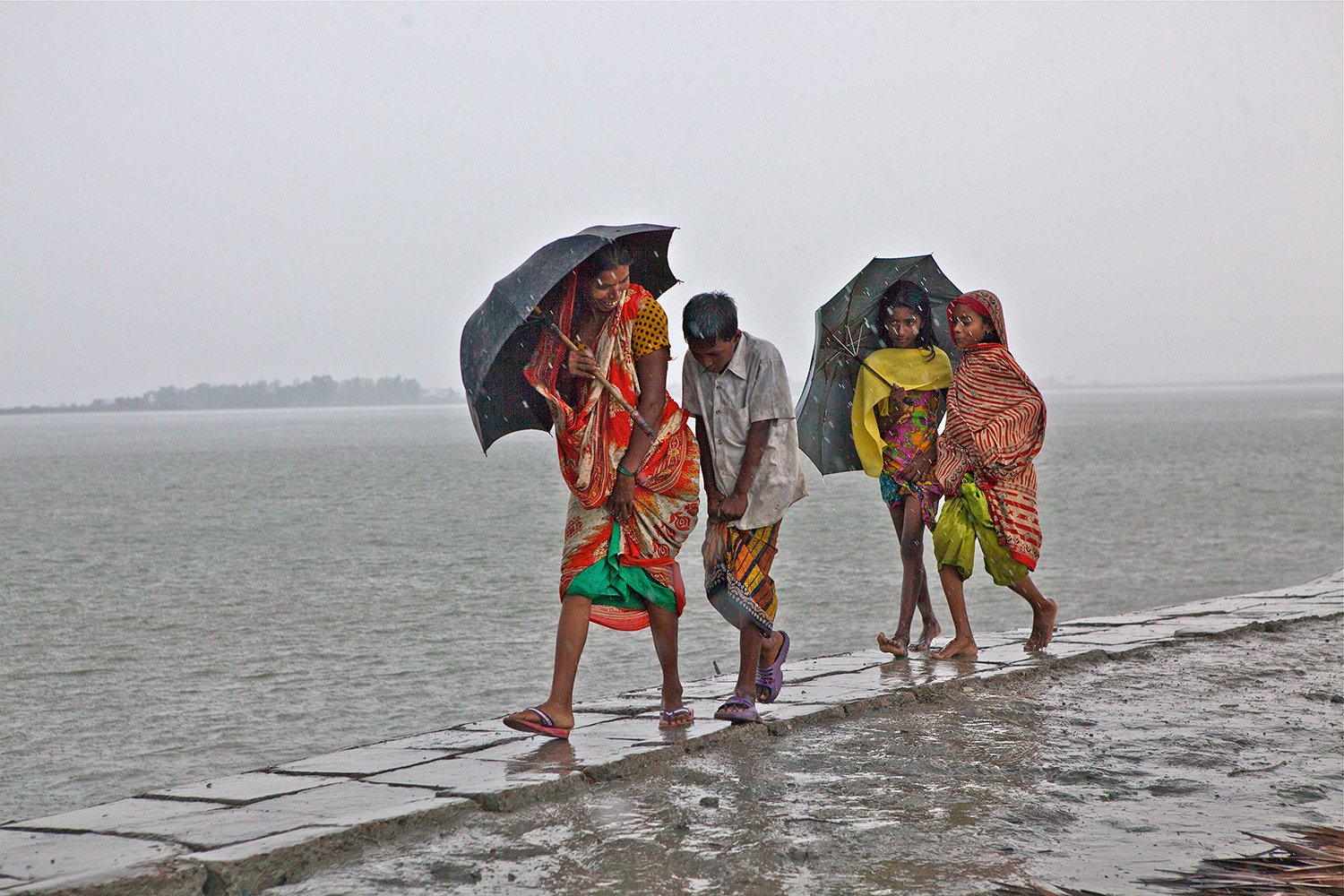From Flooded Shores to Uncertain Futures

Dispatch
From Flooded Shores to Uncertain Futures
Bangladeshi climate refugees are streaming into India—and revealing the strained future of global migration.
Villagers brave monsoon rains in an area in Bangladesh struck by Cyclone Aila on March 25, 2009. David Bathgate/Corbis via Getty Images
SUNDERBANS, West Bengal—Thirty-year-old Sita*, originally from a coastal region of Bangladesh, recalls the day Cyclone Aila struck with chilling clarity. Her house made from mud and thatch crumbled from the impact.
“It began like any other day, until a sudden shift in the air warned us of an impending disaster,” she said.
SUNDERBANS, West Bengal—Thirty-year-old Sita*, originally from a coastal region of Bangladesh, recalls the day Cyclone Aila struck with chilling clarity. Her house made from mud and thatch crumbled from the impact.
“It began like any other day, until a sudden shift in the air warned us of an impending disaster,” she said.
“We heard people screaming that the riverbank had broken, and the water was rapidly heading toward the village,” she recalled while sitting on the floor outside her brick-and-mortar house in the Sunderbans area of West Bengal, where she now lives. When she went back a few days later, everything had been washed away. Nothing was left of what was once her home.
“We lost everything—our home, our possessions, everything,” she recalled, her voice heavy with memory.
According to the Global Climate Risk Index 2021, Bangladesh ranks seventh in countries most affected by climate change since 2000. The World Health Organization reports that in 2022 alone, more than 7.1 million Bangladeshis were displaced as a result of it. The Intergovernmental Panel on Climate Change estimates that sea level rise will inundate soil with salt, reduce crop productivity, and increase poverty by 15 percent by 2030.
The issue of migration and the impacts of climate change, however, are not confined to Bangladesh alone. The Sundarbans, the world’s largest mangrove forest, shared by India and Bangladesh, lies at the heart of this mobility.
While most climate-related displacement is internal, many Bangladeshis migrate to India through porous borders. Informational circulars in the Indian Border Security Force camps on one such border in Panitar highlighted these infiltrations as a recurring issue.
The illegal nature of such movement makes it difficult to determine the exact number of Bangladeshi migrants in India. However, the Asian Development Bank states that this could be the largest international migration flow, surpassing migration across the Mexico-U.S. border.
“Migration is very frequent between Bangladesh and India, particularly from the Sundarbans area. People have friends, neighbors, and relatives there, so they cross the border—sometimes legally, sometimes illegally,” explained Md Shamsuddoha, the chief executive of the Center for Participatory Research and Development, a policy think tank in Bangladesh.
“As you call them refugees, they are not refugees that are stateless and persecuted by the government, like the Rohingyas. However, in Bangladesh, this is not the case because the government is not forcing them to leave the country. Those moving to India are crossing the border voluntarily.”
Ashok Swain, a professor and head of peace and conflict research at Uppsala University, Sweden, and the UNESCO chair of international water cooperation, highlighted the ambiguity of the term, calling it the absence of a legal framework—both domestically and internationally—that fails to recognize climate migrants as refugees. This allows both countries to overlook the issue rather than engage in a complex legal and humanitarian debate.
Fatima*, a Bangladeshi migrant who says she was trafficked to India under the false promise of a job, is seen in Basirhat, West Bengal, India, on March 7. She was rescued and is now being rehabilitated by the Basirhat Initiative for Rural Dedication.Kanika Gupta for Foreign Policy
One of the biggest concerns regarding the issue of climate-induced migration, Shamsuddoha explained, is the denial. “The government denies that people are migrating from Bangladesh to India due to climate change.”
According to a 2010 report by the U.N. Framework Convention on Climate Change (UNFCCC), estimates of Bangladeshi migrants in India vary widely. India claims there are up to 20 million illegal migrants, while Bangladesh denies any irregular migration, arguing its economy is comparable to India’s. The 2001 Indian census recorded only 280,000 Bangladeshi migrants from 1991 to 2001, though this likely excludes many undocumented movements.
The issue, Shamsuddoha added, is that many of these migrants manage to obtain Aadhaar cards, an Indian identity document, or other legal documents in India. As a result, the Indian government considers them illegal, arguing that they acquired these documents fraudulently and are Bangladeshi citizens, attempting to deport them. However, Bangladesh refuses to take them back, denying them as its citizens since they possess Indian documents.
“This is a governance issue. The Bangladeshi government sees migration to India as beneficial since people are seeking livelihoods on their own, reducing pressure on the state. Meanwhile, India views it as a source of cheap labor. These are the interests at play for both countries, in my opinion.”
India and Bangladesh’s refusal to recognize refugees under international law, coupled with their non-signatory status to the 1951 Refugee Convention, creates major obstacles to cross-border cooperation on migration. Without legal protections, climate migrants are left vulnerable, with limited rights and access to essential services. Many face human rights abuses, including trafficking, modern slavery, and inadequate access to housing, health care, and education.
The legal ambiguity surrounding climate migration between India and Bangladesh leaves vulnerable populations exposed to severe human rights challenges.
“India’s citizenship laws, such as the National Register of Citizens and the Citizenship Amendment Act, further complicate the issue, as they distinguish between migrants based on religion rather than considering climate displacement as a legitimate reason for migration. As a result, instead of recognizing and addressing climate migration through structured policies, India’s political landscape continues to treat all migration as an issue of legality and national security, making meaningful solutions for climate migrants nearly impossible,” Swain added.
Displaced villagers carry their belongings after their homes were flooded in the Koira area on the outskirts of Khulna, Bangladesh, by Cyclone Aila, on May 27, 2009. Mohir Uddin/AFP via Getty Images
While the nations argue on the verbiage, there are people like Sita and thousands of others who have lost their homes to the impacts of climate change and wonder what the future holds for them. Living deep inside the Indian state of West Bengal, one Bangladeshi migrant who arrived two years earlier hopes to assimilate rather than go back.
Sakina*, one of 13 siblings, was just 15 when her father married her off, unable to feed another mouth after his farmland became barren due to rising salinity. Then her father used all his savings to construct a new house. But when Cyclone Aila destroyed their home, the abject poverty forced the family to decide it was time for their youngest daughter to marry.
“When the cyclone came, the best houses nearby vanished, and our house was not even a house in front of those,” she recalled.
Even after marriage, Sakina couldn’t escape the wrath of extreme weather. Heavy rains frequently flooded their home, washing away their few belongings. Struggling to build a stable future, she paid an agent 6,000 rupees ($70) to help her cross into India. Today, she lives in West Bengal, posing as an Indian citizen with documents like an Aadhaar card, convinced she has finally left uncertainty behind. But she speaks in hushed tones, fearing that someone in her neighborhood might discover her true origins in Bangladesh.
The southern part of the India-Bangladesh border divides the coast and the Sundarbans. Therefore, the natural features, such as rivers, marshlands, and low-lying areas, are not suitable for installing barbed-wire fences.
Another Bangladeshi migrant, Robina*, recalled her family’s attempt to cross the border with the help of a human smuggler. He hid them in a nearby house until the following night when they finally managed to slip across, crossing a canal while hiding behind bundles of tied-together flower leaves to avoid detection.
Now she lives in another part of West Bengal, Basirhat, two hours of bumpy riding from Kolkata. Robina, originally from Satkhira in Bangladesh, moved to India two years ago in search of a better life, following a similar path to escape the relentless cycle of disaster.
A couple sit outside their makeshift shop in a village along the Indo-Bangladesh border, in West Bengal, on March 8.Kanika Gupta for Foreign Policy
India and Bangladesh share a common concern about climate change’s impact on the Sundarbans. In 2011, they signed a historic Memorandum of Understanding (MoU) that detailed actions to protect local livelihoods dependent on the ecosystem, manage the region jointly, and perform extensive research on climate change and its impact on the delta region. However, researchers claim that the only notable achievement of the MoU has been joint assessments of tigers.
Despite strong India-Bangladesh cooperation on issues like tiger conservation and water sharing, climate-induced migration remains unaddressed due to its political sensitivity. Unlike conservation efforts, which have international support, migration raises complex political, economic, and security challenges that both governments prefer to avoid, Swain said.
Shamsuddoha added that this is clearly a policy gap.
“We are working to address it as part of a regional network called Climate Action Network South Asia. We are engaging with policymakers in both Bangladesh and India to push for a common stance, ensuring that people do not suffer due to this gap or end up being considered stateless. However, the challenge remains that the Bangladeshi government continues to deny the existence of climate-induced migration to India. Similarly, the Indian government lacks a focused policy recognizing that people from Bangladesh are migrating due to climate change and displacement. This policy inertia persists on both sides.”
A fisherman works by the river in Jharkhali, Sundarbans Tiger Reserve, West Bengal, on March 9.Kanika Gupta for Foreign Policy
Michael Kugelman, Foreign Policy author and expert specializing in South Asia and the director of the South Asia Institute at the Wilson Center, said: “Given that climate change effects will be intensifying, suggesting increases in climate migrants and migrant flows into India, there’s a crying need for Delhi and Dhaka to start talking about these issues. That’s unlikely to happen at least until there are elections in Bangladesh and there’s a new government in power that India is comfortable working with.”
Illegal immigration from Bangladesh to India, including refugees and economic migrants, remains unchecked. While no exact figure exists, an analysis of population and demographic data from the 1981, 1991, 2001, and 2011 censuses suggests the number exceeds 15 million.
“You also need to mobilize media opinion and civil society while engaging directly with political stakeholders—not just the bureaucracy, but also members of parliament—so they can take a common position, perhaps even start monitoring how many people are crossing the border,” Shamsuddoha added. “If we could establish that migration is happening, it would be a step forward. But right now, both governments are in denial—Bangladesh refuses to acknowledge climate migration to India, while those who do cross over try to blend in as Indian citizens. It’s a constant game of hide and seek.”
He described India and Bangladesh’s bilateral relationship as “businesslike,” stating that despite years of alliance, the two countries have failed to address climate migration, as the interests of the Bangladeshi people were never a priority.
“The relationship between India and Bangladesh has been strong, but it did not address the real issues faced by the people. It feels more like a business arrangement—India prioritizes its interests, focusing on securing trade corridors and market access in Bangladesh, while ignoring long-standing concerns like the Teesta Barrage, Ganges water-sharing disputes, and joint climate adaptation efforts under the UNFCCC. The discussions revolve around increasing investment in Bangladesh, benefiting companies like Adani, rather than addressing the needs of the Bangladeshi people. The relationship was one-sided, serving India’s interests, while Bangladesh’s government relied on India’s support to stay in power. For the past 15 years, India has backed an undemocratic government in Bangladesh, so it will, of course, take some benefit out of it. And India did,” Shamsuddoha said.
However, Swain insisted that the politicization of the issue has made it impossible for the historical allies to find common ground vis-à-vis their climate migrant situation.
These ongoing issues of statelessness and displacement are exacerbated by the growing political and environmental tensions between India and Bangladesh. The recent political upheaval in Bangladesh, marked by the fall of the Hasina government and her subsequent refuge in India, has complicated bilateral relations between the two countries.
“The best way forward for India and Bangladesh is to recognize climate-induced migration as a shared developmental and humanitarian challenge rather than solely a security issue. Given their deep geographical, economic, and ecological ties, both countries would benefit from a common development policy that prioritizes climate adaptation, economic cooperation, and legal labor mobility to manage migration in a structured way,” Swain said.
*The names of migrants in this story have been changed to protect their privacy.
Kanika Gupta is an independent journalist and documentary filmmaker based in Delhi, India, with over seven years of experience. She covers a wide range of issues including human rights, conflict, climate, gender, and politics, reporting from regions such as Afghanistan, India, Bangladesh, and, most recently, Lebanon. Her work has been featured in prominent international publications, including Nikkei Asia Review, World Politics Review, Al Jazeera, BBC, among others.
More from Foreign Policy
-

A drawn illustration of a Trump whirlwind on a red background Four Explanatory Models for Trump’s Chaos
It’s clear that the second Trump administration is aiming for change—not inertia—in U.S. foreign policy.
-

Marco Rubio is seen up close, sitting on a couch beside J.D. Vance. Marco Rubio’s Soulless Crusade
The U.S. secretary of state stands for no principle other than serving the man who appointed him.
-

Soldiers from various NATO allies take part in a military exercise at the Smardan Training Area in Smardan, Romania, on Feb. 19. America Will Miss Europe’s Dependence When It’s Gone
European self-reliance for security will cost U.S. jobs, profits, and influence.
-

A collage photo illustration shows Donald Trump gesturing with arms wide. In front of him are headshots of Benjamin Netanyahu and Vlodymyr Zelensky, images of immigratns and ICE police, a tattered EU flag and America First signs. Trump’s First 100 Days on the Global Stage
Ten thinkers on what to make of the opening salvo of the president’s second term.













Join the Conversation
Commenting on this and other recent articles is just one benefit of a Foreign Policy subscription.
Already a subscriber?
.
Subscribe
Subscribe
View Comments
Join the Conversation
Join the conversation on this and other recent Foreign Policy articles when you subscribe now.
Subscribe
Subscribe
Not your account?
View Comments
Join the Conversation
Please follow our comment guidelines, stay on topic, and be civil, courteous, and respectful of others’ beliefs.
Change your username |
Log out
Change your username:
CANCEL
Confirm your username to get started.
The default username below has been generated using the first name and last initial on your FP subscriber account. Usernames may be updated at any time and must not contain inappropriate or offensive language.